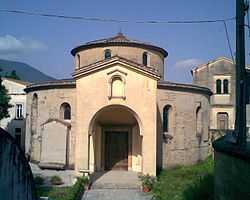Nocera Superiore
| Nocera Superiore | ||
|---|---|---|
| Comune | ||
| Comune di Nocera Superiore | ||
 | ||
| ||
 Nocera Superiore | ||
| Coordinates: 40°44′N 14°40′E / 40.733°N 14.667°E | ||
| Country | Italy | |
| Region | Campania | |
| Province | Salerno (SA) | |
| Frazioni | Croce Malloni, Materdomini, Pecorari, Uscioli, Camerelle, Pizzone, Casa Milite, Citola, Porta Romana, Pareti, Pucciano, San Clemente, San Pietro, Starza, Taverne | |
| Government | ||
| • Mayor | Gaetano Montalbano | |
| Area | ||
| • Total | 14.71 km2 (5.68 sq mi) | |
| Elevation | 70 m (230 ft) | |
| Population (1 December 2009)[1] | ||
| • Total | 24,104 | |
| • Density | 1,600/km2 (4,200/sq mi) | |
| Demonym | Nocerini | |
| Time zone | CET (UTC+1) | |
| • Summer (DST) | CEST (UTC+2) | |
| Postal code | 84015 | |
| Dialing code | 081 | |
| Patron saint | St. Cyrus | |
| Saint day | January 31 | |
Nocera Superiore is a town and comune in the province of Salerno in the Campania region of south-western Italy.
History
It was an Etruscan city, founded around the 7th century BC. After the Etruscans abandoned the area, Nuceria Alfaterna became a Samnite city, the leader of a confederation comprising Stabia, Ercolano, Pompeii and Sorrento, and with them suffered during the 62 AD earthquake and the eruption of Mount Vesuvius in 79 AD. During the Samnite Wars it sided against ancient Rome, and in 308 BC it was destroyed by the troops of Quintus Fabius Maximus; in the Second Punic War it was an allied of Rome was besieged by Hannibal, who had its male population killed. The city had an alphabet of its own, based on the Greek and Etruscan ones, and minted coins. Its territory was ravaged during the Social War (90 BC) and by the troops of Spartacus.
After the fall of the Western Roman Empire, it was briefly ruled by the Ostrogoths; after having been reacquired by the Eastern Roman Empire, it was besieged by the Lombards of Arechis I of Benevento who captured it in 601, and selected Nocera as a county seat, as part of the Duchy of Benevento. After the mid-9th century Nocera was part of the principality of Salerno first, and then of the principality of Capua. In the 12th century it was destroyed by Roger II of Sicily, who fought here a battle in 1132; most the population moved to what is now Nocera Inferiore. Rebuilt, it was known as Nuceria Christianorum under the Angevine Kings of Naples (1266-1435). In the 15th century it was renamed as Nocera de' Pagani.
Main sights
- Palaeo-Christian Baptistery of Santa Maria Maggiore. It is a 6th-century circular structure, based on Byzantine style; it houses the second largest baptismal font in Italy. It has a double row of 15 columns, having capitals from other buildings, and supporting a dome.
- Materdomini Basilica
See also
- Old Italic alphabet
